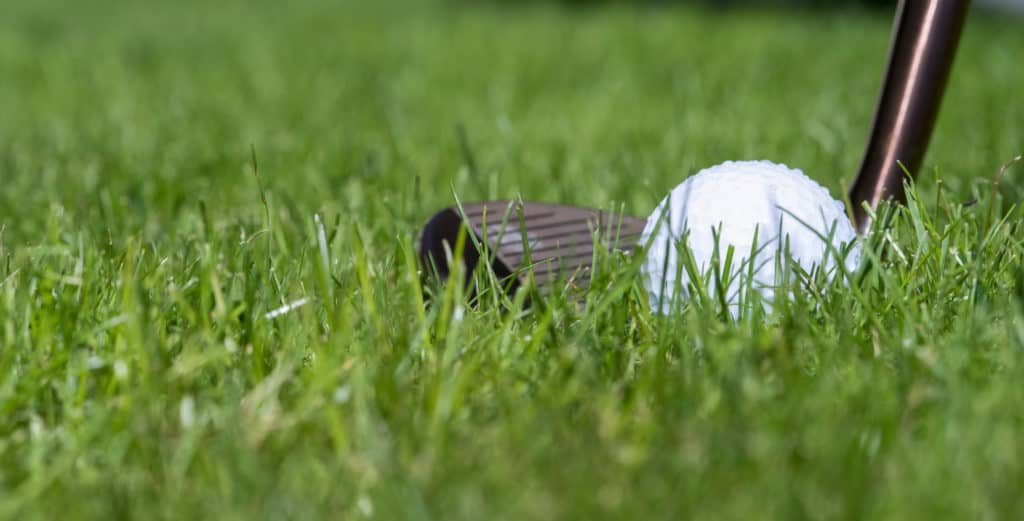Some of the old school advice or comments you might have heard about chipping includes:
- Your lob wedge is destroying your short game.
- Always get the ball onto the putting surface as soon as possible.
- The lob wedge is difficult to chip with.
The reality is that in order to play golf at least at an average level, you need to be able to chip with your lob wedge.
To play golf at a single digit handicap level, you must be able to hit the chip shot that gets up in the air and stops quickly, unless you are just going to accept your bogey everytime you miss the green and head to the next hole.
The really good news is that with average technique and some time around the greens, you can become pretty good at this shot!
Today’s courses have many undulations, difficult bunker complexes and fast, firm greens. Gone are the days of playing a bump and run up the middle of the hole and let the green slow the ball down.
As golf courses get more complicated and conditions more firm, hitting higher lofted shots into green with chips, pitches and even full swing wedges is important.
The game is played much more through the air and with good reason.
Chipping With A Lob Wedge: 5 Tips
- Learn the lower flying lob wedge chip
- Learn the higher flying lob wedge chip
- Use your lob wedge from the sand
- Use the bounce
- Practice as much as possible

Tip #1: Learn the lower flying lob wedge chip
There are two different approaches to chipping. !) Some golfers will use 3, 4, 5 or even 6 clubs to hit a variety of chip shots. 2) Some will use one club primarily. We like to recommend using 1 of 2 clubs. Either the lob wedge or the 8 iron.
Lob Wedge vs Pitching Wedge (Key Differences)
We believe in getting comfortable with the 60 and using it for a high percentage of the time around the greens. The comfort over time builds as well as the confidence level. The golfer can hit many different shots with the one club instead of many different shots with 6 different clubs. When it is time for a simple bump and run, this is where we use the 8 iron.
The low flying lob wedge chip is ideal in many situations. It allows the golfer to play the ball back in their stance and ensure they make clear, crisp contact by keeping the motion simple and repetitive.
We would recommend playing the ball just off the back foot and making an extended putting like motion. You can change the speed or the length of the movement to add or takeaway distance. There are some variables you can change to impact your distance: length of swing and speed of swing. Here are the different combinations:
- Slow speed and short motion
- Medium speed and short motion
- Fast speed and short motion
- Slow speed and medium motion
- Medium speed and medium motion
- Fast speed and medium motion
- Slow speed and long motion
- Medium speed and long motion
- Fast speed and long motion
The golfer can also alter the amount of loft with the lob wedge and provide less or more loft by changing the ball position or moving his or her hands back or forward.

Tip #2: Learn the higher flying lob wedge chip
Even the best golfers miss greens in difficult locations. Being able to hit a higher flying chip shot that will stop quickly is important to giving yourself a chance for par. If you can’t hit this shot, you are going to get stuck hitting a pitching wedge and watching it roll 20-30 feet away and hoping that you can at least 2 putt.
Lob Wedge vs Approach Wedge (Key Differences)
Here are some quick tips for this shot:
- Play the ball a bit forward in the stance
- Move your hands to equal or behind the ball
- Keep consistent pace through the shot
- Don’t stab at the ball, but instead let the club slide under and through the golf ball
Ultimately, the golfer needs to get out and hit this shot and get comfortable with the low point of the chipping motion and how the club will interact with the ground and the grass. If the ball is sitting in heavier rough, this allows the golfer to play the ball more forward and open the club face even more.
Lob Wedge vs Sand Wedge (Key Differences)

Tip #3: Use your lob wedge from the sand
Many people will ask, can I use my lob wedge from the sand? Yes, in fact you should probably use the lob wedge for a high percentage of your greenside sand shots. It provides the most loft and the best chance of a sand save. Once again, to play golf at a quality level, a golfer must be able to get the ball up in the air and stopping on the green quickly. The lob wedge provides the best options right out of the sand.
Once again, experiment with different options, but what you will find is that the lob wedge provides the most loft and ease to get the ball up quickly out of the bunker without worrying about the front wedge.
Tip #4: Use the bounce
Golf wedges are designed with different levels of bounce on the club. The best golfers use the bounce from tight lies to allow the club to slide and interact with the ground without blading or chunking the shot.
For years, golfers tried using the leading wedge, but this can often be disastrous unless you have a really good set of hands. When the bounce is utilized it actually enables the golfer to hit an inch or two behind the ball and still get a decent result.
Full Post: Using the Bounce When Chipping (7 Tips)

Tip #5: Practice as much as possible
The great news for golfers is that becoming a short game expert doesn’t take great speed, athletic ability, size or strength. Instead a golfer with some decent technique and plenty of time can build up their touch and options around the greens. Here is a great game to help you learn to compete and get up and down for par.
When I am practicing my short game, after hitting a variety of chip shots for 15-20 minutes, I like to test and assess my game with the following drill:
- I throw the ball to a random spot around the practice green.
- I go through my process of deciding what shot I am going to hit.
- I hit the shot towards the determined hole.
- I see if I can then make the putt.
- I keep track out of 20 attempts how many times I can hit one chip and one putt out of the 20 attempts.
- I monitor this over time and expect a number between 14 and 15 out of 20. This will often translate to around 50-60% scrambling rate on the golf course.
I find this to be helpful vs simple block practice as I am forced to hit different shots, from different lies to different holes and then make the putt. It keeps the pressure on because I have a goal out of 20 how many times I expect to be successful. It also gives me a benchmark to track over time to see if I am improving.
Final Thoughts: Practice and Have Fun!
Turn the lob wedge into one of your favorite clubs. The more a golfer can have confidence with the lob wedge, the better chance of scoring in the low 70s. Have fun with the game above and compete with yourself and develop your ability to get up and down to save par. Don’t just default to using other clubs and instead learn to hit the lob wedge with a high level of success. It will be a game changer in your golf journey!
Related Posts
- Chipping with an 8 Iron
- Chipping with an Hybrid
- Chipping with a 9 Iron
- Chipping with a 7 Iron
- Chipping vs Putting
My Secret To Golf Improvement
Let’s face it, in order to get really good at golf, we must practice frequently. About four years ago, I made the leap and invested in a golf simulator build for my garage. I went with a SkyTrak Launch Monitor and the TGC software and can now play over 100,000 courses including Augusta, Pebble Beach, Bethpage Black, Whistling Straits. St. Andrews and many other of the top 100 courses in the world.
This golf simulator setup, which is more affordable that you might imagine, has been a game changer. I can now play golf everyday of the year regardless of rain, snow, cold weather or time of day. I can practice or play rounds of golf. I can stand in the 11th fairway at Augusta and with the auto-rewind feature I am able to practice my approach shots from various differences.
It is worth checking out through Rain or Shine Golf as they offer some incredible packages along with financing offers that are difficult to beat.
Some direct links to Rain or Shine Golf for pricing and financing:
Take Action – What You Can Do Today to Get Better
What does this mean for you? I believe in the following recipe to get better:
1 – Improve your motion in the golf swing by identifying a golf instructor. Here are some options:
Here is a list of golf instructors that we have reviewed:
2 – Train to swing faster and improve your swing speed. Here are some options:
Looking to gain more Speed and Distance in your swing. Two Options:
3 – Understand course strategy and work to break through your next barrier. Here is a series on breaking through:
We have provided guides on how to break 100, 90, 80 and 70. Check out more below, if interested.
4 – Practice Frequently
Did you know that I build a golf simulator in my garage and have played over 500 rounds of golf on my SkyTrak system? It has been a game changer and one worth checking out. Here are some of my other posts on golf simulators frequently asked questions:
- Is a Golf Simulator Worth It?
- How to Build a Golf Simulator?
- What is the Best Golf Simulator?
- Golf Simulator Accessories?
- How to Build a Golf Simulator for under $7000
- Top 11 Reasons to Buy a SkyTrak
- How to Build a Golf Simulator for Under $1000
- Why Build A Golf Simulator?
- What Space is Needed?
- Can A Golf Simulator Improve My Game?
- How Much Does A Golf Simulator Cost?
- Don’t Forget to Check out our 15 best golf swings of all time.
